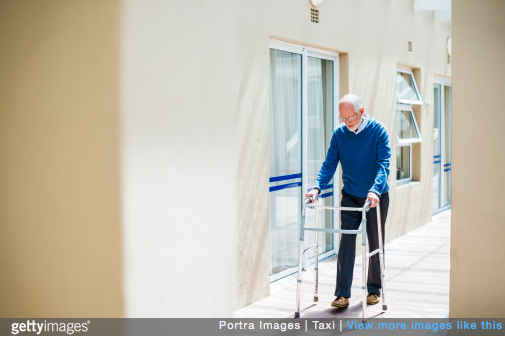By Allegra Abramo and Jennifer Lehman, Special to ProPublica
By Allegra Abramo and Jennifer Lehman, Special to ProPublica
Charlie Stewart was looking forward to getting out of the nursing home in time for his 60th birthday. On his planned release day, in late 2012, the Long Island facility instead called Stewart’s wife to say he was being sent to the hospital with a fever.
When his wife, Jeanne, met him there, the stench of rotting flesh made it difficult to sit near her husband. The small wounds on his right foot that had been healing when Stewart entered the nursing home now blackened his entire shin.
“When I saw it at the hospital … I almost threw up,” Jeanne Stewart said. “It was disgusting. I said, ‘It looks like somebody took a match to it.’ ”
Doctors told Stewart the infection in his leg was poisoning his body. To save his life, they would have to amputate above the knee.
Stewart had spent about six weeks recovering from a diabetic emergency at Avalon Gardens Rehabilitation & Health Care Center on Long Island. The nursing home is one of several in a group of for-profit homes affiliated with SentosaCare, LLC, that have a record of repeat fines, violations and complaints for deficient care in recent years.
Despite that record, SentosaCare founder Benjamin Landa, partner Bent Philipson and family members have been able to expand their nursing home ownerships in New York, easily clearing regulatory reviews meant to be a check on repeat offenders. SentosaCare is now the state’s largest nursing home network, with at least 25 facilities and nearly 5,400 beds.
That unhindered expansion highlights the continued weakness of nursing home oversight in New York, an investigation by ProPublica found, and exposes gaps in the state’s system for vetting parties who apply to buy shares in homes.
State law requires a “character-and-competence” review of buyers before a change in ownership can go through. To pass muster, other health care facilities associated with the buyers must have a record of high-quality care.
The decision maker in these deals is the state’s Public Health and Health Planning Council, a body of appointed officials, many from inside the health care industry. The council has substantial leverage to press nursing home applicants to improve quality, but an examination of dozens of transactions in recent years show that power is seldom used.
Moreover, records show that the council hasn’t always had complete information about all the violations and fines at nursing homes owned by or affiliated with applicants it reviewed. That’s because the Department of Health, which prepares character-and-competence recommendations for the council, doesn’t report them all.
The department’s assessments of Landa and other owners of SentosaCare homes have routinely found that the facilities provided a “substantially consistent high level of care” – the standard owners must meet to receive council approval.
Yet the agency’s assessments in 15 separate ownership applications since 2013 did not mention at least 20 federal fines paid by the group’s homes, records show. In more than a dozen cases, the department reported “no repeat violations,” even when a SentosaCare home had been cited multiple times for the same serious deficiency.
Many of the nursing home deals ProPublica reviewed received a go-ahead despite rules saying they “shall not be” approved when facilities have repeat violations that put residents at risk. Under a narrow interpretation of the rules, however, the department still recommends approval if violations aren’t strictly identical or were promptly addressed.
SentosaCare’s owners or associates weren’t the only applicants to get incomplete vetting, but the council has had repeated opportunities to scrutinize their records. Landa, Philipson or relatives bought shares in a dozen homes in 2013 and 2014, records show.
Advocates for nursing home patients say that instead of a backstop, New York’s approval process has become a rubber stamp.
“The law establishes mechanisms for at least a moderate review of an applicant’s character and competence,” said Richard Mollot, director of the Long Term Care Community Coalition in New York. “The failure to provide complete information on a provider’s past performance fundamentally undermines the review process.”
Mollot’s group published a recent report saying the Health Department has one of the nation’s lowest rates of citing nursing home operators for deficiencies in care. New York is also among a minority of states that don’t mandate minimum staffing ratios, even though research shows a strong link between nursing staff and residents’ well-being.
Thirteen of SentosaCare’s homes (though not Avalon Gardens) have Medicare’s bottom score for nurse staffing. Inspection reports also show that at least seven residents have wandered away from the SentosaCare affiliated facilities in recent years — including one who froze to death in 2011. Inspectors and prosecutors have found that staff falsified records in some cases. Dozens of patients at SentosaCare homes have experienced long delays before receiving necessary care; some ended up in hospitals.
The Stewarts said the staff at Avalon Gardens showed “no sense of urgency” when they complained about missed meals, soiled sheets and unanswered call bells. Even though nurses dressed the wound on Charlie’s leg daily, and a doctor checked it each week, no one warned them about its worsening condition, the Stewarts said.
Dr. Kris Alman, a retired endocrinologist who reviewed Stewart’s medical records and photographs at ProPublica’s request, said that the two quarter-sized lesions on his foot when he was admitted to Avalon Gardens could not have “become what it did overnight.” That the condition “progressed as far as it did, with him coming in septic and needing an above-the-knee amputation, was inexcusable,” Alman said.
Landa’s attorney and business partner, Howard Fensterman, declined to comment on Stewart’s case for reasons of patient privacy. Fensterman defended Avalon Gardens and other SentosaCare facilities, however, saying that when inspectors have found problems, the homes quickly addressed them and secured state approval of correction plans.
Fensterman also said that SentosaCare does not have “ownership or control” over the facilities in its network and only contracts with them to provide administrative and rehabilitation consulting, regulatory advice and purchasing services. Records show, however, that Landa and Philipson, or family members, have ownership stakes or directorships in nearly all of SentosaCare’s facilities. Fensterman also co-owns 14 nursing homes with Landa in several states, including one SentosaCare home.
Fensterman is a former member of the state health council, as is Landa, who entered the nursing home business in the late 1980s and emerged as one of the sector’s biggest players over the next decade. Landa, Philipson or family members now hold stakes in at least 33 nursing homes in New York and an equal number in nine other states.
In 2013, the latest year for which state data is available, homes under the SentosaCare umbrella paid the company more than $11.5 million for financial, staffing and other services, and spent nearly $630,000 with Fensterman’s law firm.
The nation’s $137 billion nursing home industry has made major improvements since the landmark 1987 federal Nursing Home Reform Act imposed mandates to combat abuse and neglect. But the industry, which draws heavily on taxpayer funding via Medicare and Medicaid, still struggles to provide safe care for many.
One-third of Medicare patients suffered preventable harm within a month of being admitted to nursing homes for short-term rehabilitation, according to a 2014 study by the Department of Health and Human Services’ inspector general. The harm cost Medicare $2.8 billion for hospitalizations alone in 2011, the study estimated.
New York spends about $13 billion each year on the state’s 627 nursing homes, which collectively care for more than 100,000 residents. The Department of Health is charged with day-to-day oversight of safety, but patient advocates say the agency lacks the staff and expertise to do the job adequately.
SentosaCare homes, which took in nearly $538 million from Medicare and Medicaid in 2013, aren’t the only facilities in the state with repeat violations and low staffing, and several of the company’s homes have above-average ratings on Medicare’s Nursing Home Compare web site, which rates them with one to five stars. (State-by-state inspection reports can be searched on ProPublica’s Nursing Home Inspect, which also lists deficiencies by severity level.)
But federal data through August shows that 11 of SentosaCare’s homes exceeded the state average of 24 violations over the past three years, and three had double that number.
The most critical nursing home deficiencies are known as “immediate jeopardy” violations — incidents or conditions that have caused or are likely to cause the “serious injury, harm, impairment, or death” of patients. Less than 6 percent of all New York homes were cited for four or more immediate-jeopardy violations in recent years.
By comparison, Avalon Gardens was cited for 10 immediate-jeopardy violations in the three years ending in August, the third-highest number in the state for that period. Two other SentosaCare homes — Woodmere Rehabilitation & Health Care Center and South Point Plaza Nursing and Rehabilitation Center — each have been cited for four.
Elopements — where residents leave the premises without the knowledge of a home’s operators — have been a repeat problem for Avalon and Woodmere, where SentosaCare co-owner Philipson has been listed as longtime managing partner.
Two days before Thanksgiving in 2011, a group of Woodmere residents walked to a nearby school for a holiday lunch. When aides took a head count, one of the 19 residents, a 55-year-old with dementia named Dennis Buckham, was missing.
Buckham wasn’t found until four days later, face down on a Brooklyn sidewalk, frozen and without a pulse. He died of cardiac arrest and hypothermia, according to the chief medical examiner’s report cited in the Department of Health investigation.
Fensterman said Woodmere overhauled its policies and procedures, and that the state signed off on an official plan of correction. Two years later, however, a 64-year-old Woodmere resident with schizophrenia left a secure unit 10 times over three months. Staffers found her in the basement and at the front door, but according to the state’s report, the home did not investigate, change her care plan or conduct a doctor-ordered psychiatric evaluation.
About a month later, the woman walked past a security guard and was found in the road. Fensterman said no harm resulted, the home fired the security guard who let the resident slip out, and the state again approved a correction plan.
Residents also wandered from Avalon Gardens in 2011 and 2013, state inspection reports show. In all, at least seven residents wandered away from SentosaCare facilities between 2011 and 2014, according to state inspection reports.
The reports also document dozens of cases of delayed treatment at SentosaCare homes. At Woodmere in 2012, staffers failed to promptly send four patients to the hospital, two of whom died. Two years later, a resident at Parkview Care and Rehabilitation Center in Nassau County suffered from a collapsed lung for four days while staff failed to check results from a chest X-ray or assess his breathing or vital signs.
Fensterman said that each SentosaCare home is distinct. “There is no pattern of delayed treatment among facilities,” he said, “as each facility cited had separate issues, which in no way relate to each other.” He said the Health Department found the incidents to be isolated and that all were corrected.
On multiple occasions, state inspectors discovered that staff at SentosaCare facilities tried to cover up lapses in care — allegedly lying about elopements or the failure to spot bedsores, for example. After a 2012 investigation by New York Attorney General Eric Schneiderman, the administrator of The Hamptons Center for Rehabilitation and Nursing, a SentosaCare home in Suffolk County, pled guilty to falsifying records after a resident wandered away and was found walking on the highway five hours later. The administrator was sentenced to a $2,500 fine and probation.
In June, after another investigation by Schneiderman’s office, four Woodmere nurses were arrested for falsely signing off on forms saying they had checked on a resident who fell three times in a week and ended up hospitalized. Three pleaded guilty to misdemeanors; the fourth case is pending.
Researchers and patient advocates say that insufficient staffing is one of the biggest contributors to poor outcomes for nursing home residents. The issue is important enough that the federal Centers for Medicare and Medicaid Services (CMS) tracks staffing and has determined that less than 4.1 hours of total daily nursing care per long-term resident increases the risk of bed sores, weight loss and other types of harm to patients.
“Direct bedside nursing home staff is probably the most important factor in nursing home care — end of story,” said Dr. Michele Bellantoni, clinical director of geriatrics at the Johns Hopkins School of Medicine.
Only three SentosaCare homes meet the 4.1-hour threshold, however. Six provide less than three hours of daily nursing care per resident, according to data the facilities self-report to CMS.
Fensterman said CMS’ overall staff ratings are not a good measure for comparing homes because they don’t reflect the different nursing needs of homes’ patients or high scores on other quality measures. As an example, he cited Park Avenue Extended Care, another SentosaCare facility, which CMS rated with one star on staffing but five stars for health quality, which tracks data such as how often patients get bedsores or infections.
On the other end of the scale is Avalon, with nearly 45 percent more complaints and double the number of complaint-related citations per 100 beds than the averages found in New York homes. In its most recent inspection, this past June, Avalon was cited for 21 deficiencies. Among them: Eight residents received medications up to three hours late because the facility did not have sufficient nursing staff.
Tom Bennett, 60, spent about a month in short-term rehabilitation at Avalon Gardens in 2013. Obesity and a back injury made it impossible for the Long Island man to get out of bed. In an interview, he said he didn’t receive regular sponge baths and sometimes sat in his own feces for hours because no one was available to help.
“They were all over-worked. They were telling me, you know, we just don’t have enough help to take care of everybody,” Bennett said. “And you can hear the buzzers going off constantly — meep, meep, meep, meep. And the aides are just like running from room to room to room.”
Fensterman declined to comment about Bennett’s situation. State records list SentosaCare partners Landa and Philipson as co-owners of Avalon Gardens, each with an interest of more than 30 percent. In 2013, the home reported paying $1 million to SentosaCare for services and $90,000 to Fensterman’s firm.
Although New York doesn’t mandate minimum staffing ratios, federal law says homes must have “sufficient staff” to “attain or maintain the highest practicable physical, mental, and psychosocial well-being of each resident.”
Patient advocates say that vague standard is one reason that the state rarely cites homes for insufficient staffing. Health Department officials, in response to an email asking about the agency’s citation rate, also noted the lack of specific minimum staffing rules.
Avalon Gardens and a second SentosaCare home, South Point Plaza Nursing and Rehabilitation Center on Long Island, were among only 29 cited specifically for insufficient staffing in the past three years.
Patient advocates say lack of staff is one of the most common complaints from residents and that state inspectors should be following federal guidance, which instructs them to look for staffing issues “whenever quality of care problems have been discovered.”
Advocacy groups and the state’s biggest nurses’ union have pushed for mandatory staffing ratios, and “safe-staffing” bills have been introduced in the New York Legislature for at least a decade, according to the office of Assemblyman Richard Gottfried, D-Manhattan, the health committee chairman. Hospitals and nursing homes have objected, saying the mandates would be too costly.
Mollot said that while legislating a staffing floor would help, the key is whether the Health Department does more to police the problem. If a new staffing law “just becomes another requirement that’s not enforced,” he said, “what good is it?”
When nursing home ownership changes hands in New York, character-and-competence reviews are supposed to provide an important checkpoint.
State law gives the Public Health and Health Planning Council the power to bar new owners or directors based on the compliance record of any facility they are “affiliated” with. “If some bad actor wanted to buy a new nursing home,” said Susan Regan, a lawyer who spent 18 years on council, “we could say no.”
Except the council seldom says “no.”
ProPublica’s review of Health Department and council records did not turn up any nursing home ownership applications within the last five years that were rejected because of lapses in patient care. In most cases, the council — 24 volunteers appointed by the governor — follows the department’s recommendations.
Although the department’s reviews summarize past violations and fines at an applicant’s related facilities, they typically conclude there is a “substantially consistent high quality of care.” Regulations say applicants “shall not” receive such a finding if a facility’s violations were “recurrent or were not promptly corrected.”
But the council doesn’t always get a look at the complete record.
Thanks to home purchases and shuffling of ownership shares, Landa, Philipson, their family members and other owners of SentosaCare facilities have come up for council reviews a dozen times since 2013. In addition to omitting mention of at least 20 federal fines paid by SentosaCare homes, the department’s reviews reported “no repeat violations” a dozen times when there had been multiple citations for the same problems.
Since 2011, Woodmere has been cited and fined several times for the same class of violations that put residents in immediate jeopardy, including giving unnecessary medications and failing to protect residents from falls. The home paid more than $80,000 in federal fines, which are shared with the state. In 2013, the federal government also temporarily halted payments for new admissions at Woodmere, a stiff penalty for homes with ongoing problems.
None of those actions was noted in character-and-competence summaries provided to council members on at least three occasions in 2013 and 2014, when Landa, Philipson and others associated with Woodmere applied to buy shares of other nursing homes. Instead, the department wrote that Woodmere had “no enforcements” or made no mention of the home.
In each case, the department recommended approval, and the council voted in favor without any objections. Records list Landa as a director and Philipson as the managing partner of Woodmere. Fensterman, who served on the council from 2010 until 2014, recused himself from votes involving business partners and clients.
When SentosaCare’s South Point Plaza was part of reviews in 2013 and 2014, the department also said it had “no repeat enforcements,” even though the home had been cited and fined more than once for residents having pressure sores. Although three state fines were noted, an additional $90,000 in federal fines and one Medicare payment denial were not included in the reviews.
Asked about the omissions, the department initially said its character-and-competence process includes federal investigations and fines. In a later statement, it said federal fines are not currently included, but that its policy is being reviewed. The agency began listing them in council papers in February, it said in an email, but only “for informational purposes.”
A review of dozens of health council applications shows that the department doesn’t always flag serious violations if there was no state fine, or if the amount isn’t finalized. The state did not settle $18,000 in fines for elopements at Woodmere and Avalon until last month, more than two years after the incidents. Recent character-and-competence reviews did not mention pending fines or report that the elopements had occurred.
About a year ago, the department began appending copies of its website pages on citations and quality ratings to council review documents. A list of deficiencies and their severity isn’t always included.
Concerning what it counts as a repeat enforcement, the agency said that while some violations may fall in the same category, they are not necessarily the same. That is consistent with its reviews, which sometimes note that violations were not “identical.”
Mollot said it was “extremely alarming” that violations and fines might be omitted.
In interviews, three former or current council members expressed uncertainty about what standards apply in character-and-competence reviews. With dozens of projects and ownership changes to vote on at each monthly meeting, council members must rely on the department’s information to do their jobs.
For many of her years on the council, Regan chaired the establishment committee, which reviews applications to buy or build facilities. Members would often ask for more details about applicants’ histories, she said, “but what you do about it is difficult.” Operators argue that they have paid their fines and corrected deficiencies, she said, or that repeat violations were not connected.
“I would argue, you know what, if you’re in business to find every opportunity to game the standards, and do the minimum, and give the shoddiest care you can possibly give while still getting out from under the deficiency, it should raise a question of whether you should hold a license,” Regan said.
Arthur Levin, a current establishment committee member, said that he and others are increasingly asking the Health Department for information about quality of care, not just violations, especially for dialysis centers. Levin is director of the Center for Medical Consumers and the council’s lone representative from a patient group.
“At the very least, let it be the basis of a question to an applicant: ‘What are you going to do to do better?’ ” Levin said.
Three years ago, the council recommended changes to character-and-competence reviews as part of a regulatory overhaul requested by Gov. Andrew Cuomo. Among the proposals was one to give the department and council more discretion to disqualify applicants for patterns of violations across multiple facilities affiliated with an applicant.
“When a proposed owner or trustee presents affiliations with a health care facility or agency that has a pattern of, or multiple, enforcements, or a sub-standard quality record, there should be a presumption of disqualification which may be rebutted in limited circumstances,” says the recommendation, which is still on the shelf.
Recent versions of the safe-staffing bill would expand character-and-competence reviews to consider not only staffing but worker safety violations like those that resulted in 13 citations and $24,600 in fines to Avalon Gardens in 2013.
In his short stay at Avalon Gardens, Charlie Stewart remembers waiting for hours for help getting from his bed to the toilet. One time, when no one answered the call bell, he started yelling, he said. Still no one came. Eventually he decided to crawl across the floor to the bathroom rather than soil the bed.
“When you need help and it’s not coming, you know, your reality changes immediately,” said Stewart. “It’s not nice feeling helpless. And several times in that place, I gotta say, I felt like I was helpless.”
On multiple occasions, Stewart said, no one brought him dinner, even though he needed to eat regularly because of his diabetes. His wife, Jeanne, said she thought pain medications were making him forgetful. But he kept calling. “I might have been drugged, but I know I wasn’t fed, ’cause I’m starving,” he recalls telling his wife.
Fensterman said privacy laws prohibited SentosaCare from responding to specific questions about Stewart’s care.
Jeanne said she called the Health Department while Charlie was still at Avalon to complain about the missed meals and lack of help getting to the bathroom. When a representative finally called back to follow up on her complaint, she told the caller she was sitting next to her husband in the hospital as he recovered from an amputation.
A few weeks later, she said, a letter arrived saying the state hadn’t substantiated the initial complaint. Furious, Jeanne threw it away.
Today, Stewart is learning how to walk up stairs on his prosthetic leg. Jeanne limits the hours in her job at a grocery store so she can care for her husband. She still finds the episode difficult to talk about.
“I felt more could have been done sooner,” she said of her husband’s care. “And it just shouldn’t have gotten as far as it did.”
Charlie Stewart agreed. “That’s what I sincerely wish — that this doesn’t happen to anybody else.”
Allegra Abramo is a freelance writer and photographer living in Seattle. Jennifer Lehman is a writer living in New York City.
ProPublica is a Pulitzer Prize-winning investigative newsroom. Sign up for their newsletter.
































